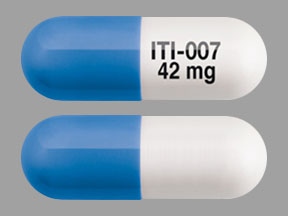Lumateperone Interactions
There are 604 drugs known to interact with lumateperone, along with 10 disease interactions, and 4 alcohol/food interactions. Of the total drug interactions, 167 are major, 435 are moderate, and 2 are minor.
- View all 604 medications that may interact with lumateperone
- View lumateperone alcohol/food interactions (4)
- View lumateperone disease interactions (10)
Most frequently checked interactions
View interaction reports for lumateperone and the medicines listed below.
- Abilify (aripiprazole)
- Adderall (amphetamine / dextroamphetamine)
- Alcohol (contained in alcoholic beverages) (ethanol)
- Augmentin (amoxicillin / clavulanate)
- Bactrim (sulfamethoxazole / trimethoprim)
- Benadryl (diphenhydramine)
- Cogentin (benztropine)
- Cymbalta (duloxetine)
- Effexor XR (venlafaxine)
- Invega (paliperidone)
- Lamictal (lamotrigine)
- Latuda (lurasidone)
- Lexapro (escitalopram)
- Linzess (linaclotide)
- Lithium Carbonate ER (lithium)
- Lybalvi (olanzapine / samidorphan)
- Lyrica (pregabalin)
- Metoprolol Succinate ER (metoprolol)
- MiraLAX (polyethylene glycol 3350)
- Mirena (levonorgestrel)
- Neurontin (gabapentin)
- Omega-3 (omega-3 polyunsaturated fatty acids)
- Seroquel (quetiapine)
- Toradol (ketorolac)
- Trintellix (vortioxetine)
- Vitamin B12 (cyanocobalamin)
- Vitamin C (ascorbic acid)
- Vitamin D3 (cholecalciferol)
- Vraylar (cariprazine)
- Vyvanse (lisdexamfetamine)
Lumateperone alcohol/food interactions
There are 4 alcohol/food interactions with lumateperone.
Lumateperone disease interactions
There are 10 disease interactions with lumateperone which include:
- suicidality
- dementia
- aspiration
- seizure
- hematologic abnormalities
- hyperglycemia/diabetes
- hypotension
- lipid alterations
- hepatic impairment
- tardive dyskinesia
More about lumateperone
- lumateperone consumer information
- Compare alternatives
- Reviews (188)
- Side effects
- Dosage information
- During pregnancy
- Drug class: atypical antipsychotics
- Breastfeeding
- En español
Related treatment guides
Drug Interaction Classification
| Highly clinically significant. Avoid combinations; the risk of the interaction outweighs the benefit. | |
| Moderately clinically significant. Usually avoid combinations; use it only under special circumstances. | |
| Minimally clinically significant. Minimize risk; assess risk and consider an alternative drug, take steps to circumvent the interaction risk and/or institute a monitoring plan. | |
| No interaction information available. |
Further information
Always consult your healthcare provider to ensure the information displayed on this page applies to your personal circumstances.


